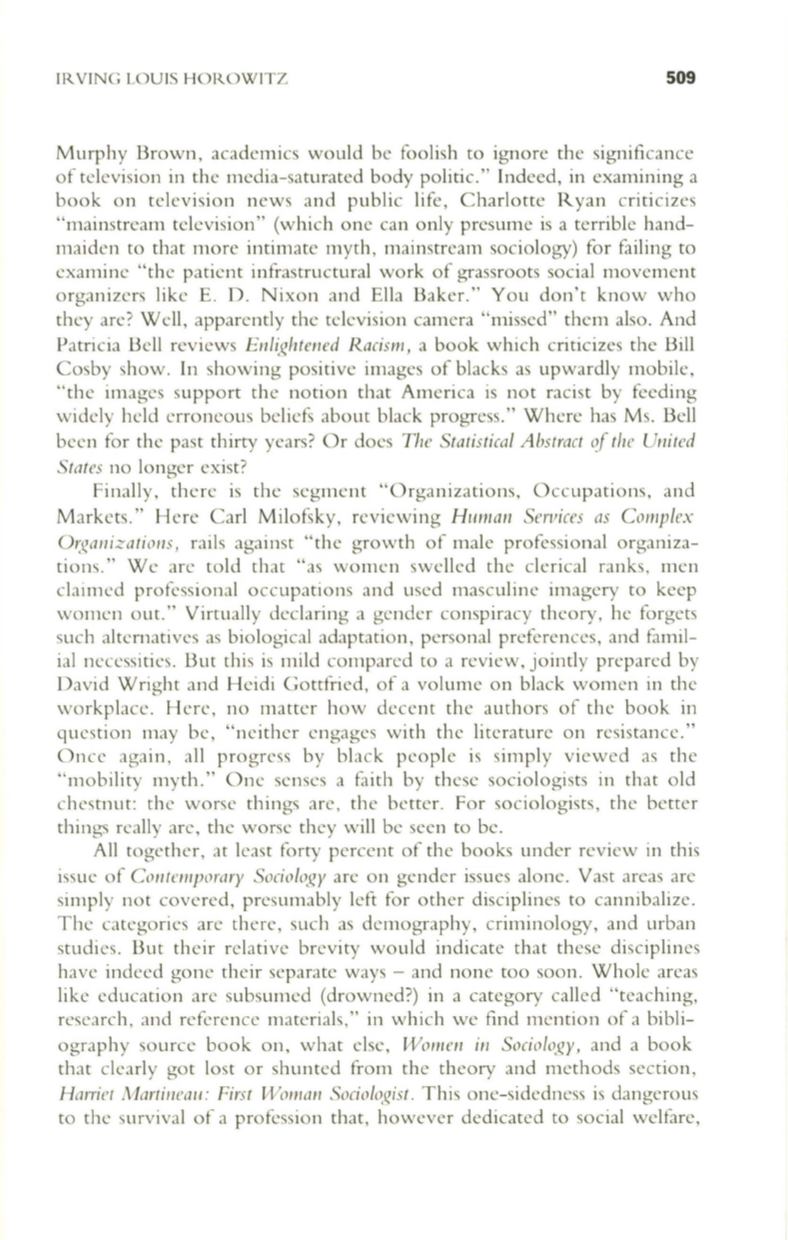
IR.VING LOUIS HOR.OWITZ
509
Murphy Brown, academics would be foolish to ignore the significance
of television in the media-saturated body politic." Indeed, in examining a
book on television news and public life, Charlotte Ryan criticizes
"mainstream television" (which one can only presume is a terrible hand–
maiden to that more intimate myth, mainstream sociology) for failing to
examine "the patient infrastructural work of grassroots social movement
organizers like E. D. Nixon and Ella Baker." You don't know who
they are? Well, apparently the television camera "missed" them also. And
Patricia Bell reviews
Enlightened Racism,
a book which criticizes the Bill
Cosby show.
In
showing positive images of blacks as upwardly mobile,
"the images support the notion that America is not racist by feeding
widely held erroneous beliefs about black progress." Where has Ms. Bell
been for the past thirty years? Or does
The Statistical Abstract oj the Urlited
States
no longer exist?
Finally, there is the segment "Organizations, Occupations, and
Markets." Here Carl Milofsky, reviewing
HI/man SeYTl;ces as Complex
Organizations,
rails against "the growth of male professional organiza–
tions." Weare told that "as women swelled the clerical ranks, men
claimed professional occupations and used masculine imagery to keep
women out." Virtually declaring a gender conspiracy theory, he forgets
such alternatives as biological adaptation, personal preferences, and famil–
ial necessities. But this is mild compared to a review, jointly prepared by
David Wright and Heidi Gottfried, of a volume on black women in the
workplace. Here, no matter how decent the authors of the book in
question may be, "neither engages with the literature on resistance."
Once again, all progress by black people is simply viewed as the
"mobility myth." One senses a faith by these sociologists in that old
chestnut: the worse things are, the better. For sociologists, the better
things really are, the worse they will be seen to be.
All together, at least forty percent of the books under review in this
issue of
Contelllporary Sociology
are on gender issues alone. Vast areas are
simply not covered, presumably left for other disciplines to cannibalize.
The categories are there, such as demography, criminology, and urban
studies. But their relative brevity would indicate that these disciplines
have indeed gone their separate ways - and none too soon. Whole areas
like education are subsumed (drowned?) in a category called "teaching,
research, and reference materials," in which we find mention of a bibli–
ography source book on, what else,
Womel1
i/1
Sociology,
and a book
that clearly got lost or shunted from the theory and methods section,
Harriet Martineau: First WOlllan Sociologist.
This one-sidedness is dangerous
to the survival of a profession that, however dedicated to social welfare,


